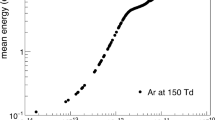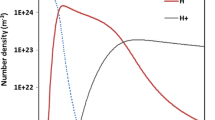Abstract
This paper presents the measurement and simulation data on the thermal and chemical structure of an atmospheric-pressure premixed H2/O2/N2 flame doped with iron pentacarbonyl Fe(CO)5. Soft ionization molecular beam mass spectrometry was used to measure concentration profiles of the combustion products of iron pentacarbonyl: Fe, FeO2, FeOH, and Fe(OH)2. A comparison of experimental and simulated concentration profiles showed that they are in satisfactory agreement for FeO2 and Fe(OH)2 and differ significantly for Fe and FeOH. Thus, the previously proposed kinetic model for the oxidation of iron pentacarbonyl was tested and it was shown that the mechanism needs further elaboration.
Similar content being viewed by others
References
U. Bonne, W. Jost, and H. G. Wagner, “Iron pentacarbonyl in methane/oxygen (on air) flames,” Fire Research Abstr. Rev., 4, 6–18 (1962).
G. Lask and H. G. Wagner, “Influence of additives on the velocity of laminar flames,” Proc. Combust. Inst., 8, 432 (1962).
D. Reinelt and G. T. Linteris, “Experimental study of the inhibition of premixed and diffusion flames by iron pentacarbonyl,” Proc. Combust. Inst., 26, 1421–1428 (1996).
M. D. Rumminger, D. Reinelt, V. Babushok, and G. T. Linteris, “Numerical study of the inhibition of premixed and diffusion flames by iron pentacarbonyl,” Combust. Flame, 116, 207–219 (1999).
M. D. Rumminger and G. T. Linteris, “Inhibition of premixed carbon monoxide-hydrogen-oxygen-nitrogen flames by iron pentacarbonyl,” Combust. Flame, 20, 451–464 (2000).
G. T. Linteris, V. R. Katta, and F. Takahashi, “Experimental and numerical evaluation of metallic compounds for suppressing cup-burner flames,” Combust. Flame, 38, 78–96 (2004).
M. D. Rumminger and G. T. Linteris, “The role of particles in the inhibition of premixed flames by iron pentacarbonyl,” Combust. Flame, 23, 82–94 (2000).
M. D. Rumminger and G. T. Linteris, “The role of particles in the inhibition of counterflow diffusion flames by iron pentacarbonyl,” Combust. Flame, 128, 145–164 (2002).
G. T. Linteris and V. Babushok, “Promotion or inhibition of hydrogen-air ignition by iron-containing species,” Proc. Combust. Inst., 32, 2535–2542 (2009).
G. T. Linteris, M. D. Rumminger, V. Babushok, and W. Tsang, “Flame inhibition by ferrocene and blends of inert and catalytic agents,” Proc. Combust. Inst., 28, 2965–2972 (2000).
K. B. Kim, K. A. Masiello, and D. W. Hahn. “Reduction of soot emissions by iron pentacarbonyl in isooctane diffusion flames,” Combust. Flame, 154, 164–180 (2008).
J. Zhang and C. M. Megaridis, “Soot suppression by ferrocene in laminar ethylene/air nonpremixed flames,” Combust. Flame, 105, 528–540 (1996).
J. B. Howard and W. J. Kausch, Jr. “Soot control by fuel additives,” Prog. Energy Combust. Sci., 6, 263–276 (1980).
N. D. Marsh, I. Preciado, E. G. Eddings, and A. F. Sarofim, “Evaluation of organometallic fuel additives for soot suppression,” Combust. Sci. Technol., 179, 987–1001 (2007).
K. Brezinsky, “Gas-phase combustion synthesis of materials,” Proc. Combust. Inst., 26, 1805–1816 (1996).
M. S. Wooldridge, “Gas-phase combustion synthesis of particles,” Prog. Energy Combust. Sci., 24, 63–87 (1998).
P. Roth, “Particle synthesis in flames,” Proc. Combust. Inst., 31, 1773–1788 (2007).
C. Janzen, P. Roth, and B. Rellinghaus, “Characteristics of Fe2O3 nanoparticles from doped low-pressure H2/O2/Ar flames,” J. Nanoparticle Res., 1, 163–167 (1999).
C. Janzen and P. Roth, “Formation and characteristics of Fe2O3 nano-particles in doped low pressure H2/O2/Ar flames,” Combust. Flame, 125, 1150–1161 (2001).
K. Tian, Z. S. Li, S. Staude, B. Li, Z. W. Sun, A. Lantz, M. Alden, and B. Atakan, “Influence of ferrocene addition to a laminar premixed propene flame: Laser diagnostics, mass spectrometry and numerical simulations,” Proc. Combust. Inst., 32, 445–452 (2009).
I. Wlokas, S. Staude, C. Hecht, B. Atakan, and C. Schulz, “Measurement and simulation of Fe-atom concentration in premixed Fe(CO)5-doped low-pressure H2/O2 flames,” in: Proc. of the 4th European Combustion Meeting., Vienna, Austria (2009).
O. P. Korobeinichev, L. V. Kuibida, A. A. Paletsky, and A. A. Chernov, “Study of solid propellant flame structure by mass-spectrometric sampling,” Combust. Sci. Technol., 113–114, 557–571 (1996).
O. P. Korobeinichev, S. B. Ilyin, V. M. Shvartsberg, and A. A. Chernov, “The destruction chemistry of organophosphorus compounds in flames,” Combust. Flame, 118, 718–732 (1999).
R. J. Kee, F. M. Rupley, and J. A. Miller, “CHEMKIN-II: A Fortran chemical kinetics package for the analysis of gas phase chemical kinetics,” Sandia National Laboratories Report No. SAND 89-8009B (1989).
R. J. Kee, J. F. Grcar, M. D. Smooke, and J. A. Miller, “PREMIX: A Fortran program for modeling laminar one-dimensional premixed flames,” Sandia National Laboratories Report No. SAND85-8240 (1985). http://www.ca.sandia.gov/chemkin/.
K. A. Burton, H. D. Ladoucer, and J. W. Fleming, “Short communication: An improved noncatalytic coating for thermocouples,” Combust. Sci. Technol., 81, 141–145 (1992).
W. E. Kaskan, “The dependence of flame temperature on mass burning velocity,” Proc. Combust. Inst., 6, 134–143 (1957).
O. P. Korobeinichev, A. G. Tereshchenko, I. D. Emelyanov, A. L. Rudnitskii, “Substantiation of the probe mass-spectrometric method for studying the structure of flames with narrow combustion zones,” Combust., Expl., Shock Waves, 21, No. 5, 524–530 (1985).
T. Turanyi, “MECHMOD v. 1.4: Program for the transformation of kinetic mechanisms,” available at http://www.chem.leeds.ac.uk/Combustion/Combustion.html.
T. Turanyi, I. G. Zsely, and C. Frouzakis, “KINALC: A CHEMKIN based program for kinetic analysis,” available at http://www.chem.leeds.ac.uk/Combustion/Combustion.html.
I. G. Zsely, I. Virag, and T. Turanyi, “FluxViewer: Visualisation tool for element fluxes,” available at http://garfield.chem.elte.hu/Combustion/fluxviewer.htm.
Author information
Authors and Affiliations
Corresponding author
Additional information
__________
Translated from Fizika Goreniya i Vzryva, Vol. 47, No. 1, pp. 3–14, January–February, 2011.
Rights and permissions
About this article
Cite this article
Gerasimov, I.E., Knyazkov, D.A., Shmakov, A.G. et al. Structure of an atmospheric-pressure H2/O2/N2 flame doped with iron pentacarbonyl. Combust Explos Shock Waves 47, 1–11 (2011). https://doi.org/10.1134/S0010508211010011
Received:
Published:
Issue Date:
DOI: https://doi.org/10.1134/S0010508211010011




